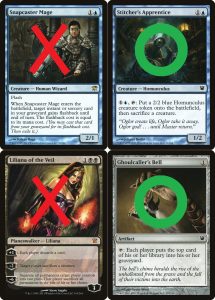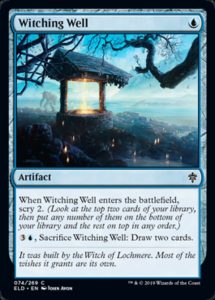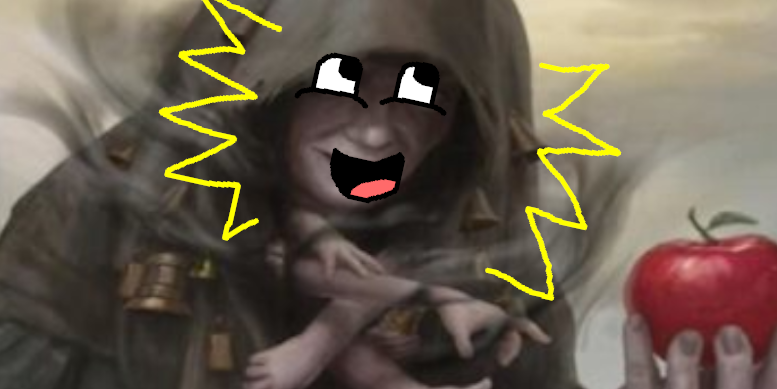Hey there! I’m Scott from the top four of last year’s Great Designer Search 3. Welcome back to another installment of Deadly Designs, where we talk about Magic card design from an outsider’s perspective.
Last time we brainstormed what some new lands might look like for the Commander format. But with the new set Throne of Eldraine just released, this week I want to take a look at what I think are the top 10 best designed cards in the new set.
For this list, more than constructed playability or flavor, we’re focused on the new design space cards carve out, the elegance of their design, and the mechanical interconnectivity they have with the rest of the set.
So think less Snapcaster and Liliana, more Stitcher’s Apprentice and Ghoulcaller’s Bell.

Even though Throne of Eldraine has a ton of cool fairy tale designs in it, I think they’ve already gotten plenty of attention. Today I want to focus on the lesser-sung heroes of the set: the nuts, bolts, and diamonds in the rough.
This is also my personal list. Your own will of course vary, and that’s awesome!
So with that out of the way let’s get started with…
#10. Witching Well

Let’s start off with a card that exemplifies what we’re looking at today. Witching Well isn’t the flashiest or most flavorful card, but it’s a great design for the set.
Cards that smooth out draws are necessary for every Magic set, but you can’t just use the same cards/mechanics over and over again or else it would get boring. Witching Well does a great job with this on two fronts:
(1) Dividing up the scry and draw makes Witching Well do exactly what you need it to at the time. On turn one, you can scry away dead draws to get what you need, in the later game you can crack it for cards, and in the much later game you can do both at once when you draw it off the top. If the scry and card draw happened at the same time, it’d have to cost more. But the way it is now, Witching Well makes keeping one-landers not necessarily a death sentence.
(2) Also, having artifacts/enchantments in play is a mini theme of Throne of Eldraine. Even though it’s usually the right call to sacrifice the Well and get your cards, there might be times when it would be more beneficial to have it in play.
For example, you might keep it in play to give your Flutterfox flying or to boost up your Shinechaser.

#9. Wishful Merfolk

Even though the flavor of this card is great, what I really like is the mechanic. A lot of sets have a blue creature with defender that you can pay mana to attack with, but this one takes that to another level, not only letting it attack, but also changing its creature type.
This is different from what we usually get with cards like this. Usually they can “attack as if it didn’t have defender,” not just straight up lose it. Similarly, whenever a creature gets a new type, usually it retains its old ones, but not here: “defender” and “Merfolk” are both gone from this card when you activate it. That’s a nice bit of design space that hasn’t been explored too much, and I’m looking forward to seeing more of it.
The thing that keeps this card lower on the list is that I wish there were a few more cards that interacted with Humans in the set. There’s a small non-Human theme, but they all interact negatively with this card, not positively.
For example, Mistford River Turtle can’t ferry it. I wish there was a card like Silver-Inlaid Dagger, so that it would get the bonus when it “transforms.”

#8. Tempting Witch

So let’s talk Food. Personally, aside from being slightly silly-sounding, I think it’s a great mechanic. It’s like Energy from Kaladesh, a different resource that certain cards interact with, but seemingly much more balanced so far. The fact that you can sacrifice excess Food if you need to and it doesn’t just sit around like unused Energy is also a great bonus.
This card in particular I like because it takes what binds all Food together — sacrifice to gain three life — and turns it on its head. In the past, cards like this that take the base mechanics of the set and really change them around, would come in the second or third sets on that plane. But now, with Magic spending usually only one set on each plane, we get them all at once, which I think is cool.
We had to wait until the third set to get cards like Phyrexian Unlife (weird Infect) or Gnarled Scarhide (downside Bestow), but now we might get them sooner, which is cool.

#7. Wicked Guardian

God this card is great. Black usually has some sort of sacrifice-something-when-this-enters-the-battlefield-to-get-a-bonus-card in each set, but this is an awesome new take on that tried and true mechanic. Instead of sacrificing another creature, you just deal damage to it, which means the creature you hit might stick around and you get the bonus.
I like this because it rewards you for building your deck in a way that takes advantage of the drawback. With Wicked Guardian in your deck, you might want to have a few more 3+ toughness creatures than usual. There aren’t a ton of “dies triggers” in Throne of Eldraine, so this is a great way to still play into the same “hurt your own stuff” mechanic in a way that works with the set.
I also love how multiple Wicked Guardians each kill each other so you can’t put too many in your deck, and how you can still have it deal 2 damage to something that it would kill in a pinch, and how it’s not mandatory, and… gah! What a great card.
Irencreg Pyromancer and Steelgaze Griffin say, “Please punish me, Mommy!”

#6. Gilded Goose

Gilded Goose isn’t the most elegant card (I feel like it might not need that third ability there), but what it does for Standard Magic is certainly elegant.
It’s no secret that Llanowar Elves is a very powerful card. Accelerating your mana for just one green is huge. Quite often, if you don’t have a way to kill a turn one Llanowar, you either are dead or you feel dead, neither of which is great.
But Gilded Goose is a nice new take on the one-drop mana dork. It accelerates for one turn, but then it must be fed to keep going. Sure, you can drop a three-cost spell on turn two, but if you don’t have any more food, then the goose is no longer loose.
Cards like this make me hopeful that we’ll see more conditional one-drop mana dorks in the future. Just like having a variety of different five-drop wraths has made for interesting builds of decks in Standard, I think the Goose and its potential-future brethren will do the same.
Maybe we’ll see something like these in a later set?

#5. The Monocolor Hate Cycle

Color hosers are tough to design. If they’re too strong, like Boil, then they’re miserable to play against. But if they’re too weak, like Autum’s Veil, then they don’t see much play.
This cycle tries something new: being more efficient against a certain color, but still usable anytime. I think that’s a great innovation, and I’m a little surprised it’s taken this long to make them.
Yes, it’s miserable to cast Spector’s Shriek and take a nonblack card, but chances are you’d only bring it in from the sideboard against a mostly-black opponent anyway, and in a pinch it’s still better than nothing.
This seems like a nice compromise for color hosers, and while I’m sure we’ll still see plenty of cards like Fry in the future that are only castable against certain colors, I wouldn’t mind seeing more like these either.
I’m just here drooling over a potential-future Fry that can hit non-white/blue things too.

#4. Giant Opportunity

This takes the “playing with Food” concept that we saw earlier to a whole new level.
As opposed to other cards that both make and use Food, this one is a Sorcery, meaning you just have one shot. Not only is that good flavor (sometimes the beans work their magic, and sometimes they’re just beans!), but it also makes the same card do different things. Sometimes you have to cast it early to stay alive or feed your creatures; sometimes you can cast it later and get a Giant.
We’ve seen cards like this before with Approach of the Second Sun, but that was a big flashy rare. I’d love to see more cards like Giant Opportunity at common/uncommon.
Cards whose modes aren’t necessarily “do something/win the game,” but “smaller value/bigger value.”

#3. Seven Dwarves

At first glance this card might seem like just a cute little flavorful insertion, but when you really think about it, it’s doing something huge.
Usually cards that let you play more than four in the deck let you play any number, like Persistent Petitioners or Relentless Rats. This makes sense. If the cards said that you could only have 20 or 30 or whatever, then it would be annoying to always make sure that everyone playing those cards had the right amount.
But now here we are with Seven Dwarves, only letting you play up to seven. That brings up the question: how will you know if someone is playing eight copies in their deck? Outside of events with deck registration, and aside from milling their entire deck, someone could play with eight or nine or ten and no one would know — it’s on the honor system. Same as how people playing at events with no deck registration hopefully don’t have five or six copies of a card in their deck.
With this “honor system” being shaken around a little bit by Seven Dwarves, will we see more cards in the future that play with deckbuilding rules? What about cards that you can only have one copy in your deck? Or two? Or that require you to have a copy of another card in your deck to play it?
A card like One With Something, that makes you play another card in your deck, makes me excited for the design space that Seven Dwarves is mining.

#2. THE LANDS YES THANK YOU

In the last Deadly Designs, we talked about how I wished that Magic had a bit more fun with lands. We have thousands of different spells and creatures, but not a ton of lands that do interesting/unique things.
But now, Throne of Eldraine has brought 11 lands that each do cool things. This is not only great to give more options to players in Eternal formats (especially Commander), but also to give players a reason to go mono colored.
As long as there’s decent mana-fixing, which there usually is in modern sets, there’s usually very little reason not to go at least two-colored when building decks. But these lands (with the exception of Tournament Grounds) encourage mono-colored decks in a cool, new way.
We still have access to shocklands and scrylands in Standard, which are good motivators to play multiple colors, but I think having similar motivators to go mono-colored is healthy for Magic, and these are a great step in the right direction.
More like these please!

#1. Gingerbrute

It’s been a while since I’ve seen a card that hits the holy trifecta: new design space, elegance, and mechanical interconnectivity, all in one deliciously flavorful card. Let’s go through it bit by bit.
Gingerbrute’s line about not being able to be blocked by creatures with haste might just seem chuckle-worthy at first, but it’s huge. Aside from a few cards like Path of Mettle in Ixalan, we haven’t seen many cards interact with haste after the creature has already come down the first turn. Gingerbrute changes that, opening up a whole new design space for cards having haste (or trample or first strike or vigilance or…).
The fact that Gingerbrute is also Food himself and can be sacrificed is just icing on the cookie. I cannot wait to see more cards like this in the future, potential opening up a flood of new, cool designs that this little guy was responsible for first cracking open.
Gingerbrute is the perfect ingredient to start baking some new ideas!

So what are your favorite designs in Throne of Eldraine? Feel free to let me know, and next time we’ll be back to take a look at the bad with the good: the Worst Designs in the set.
